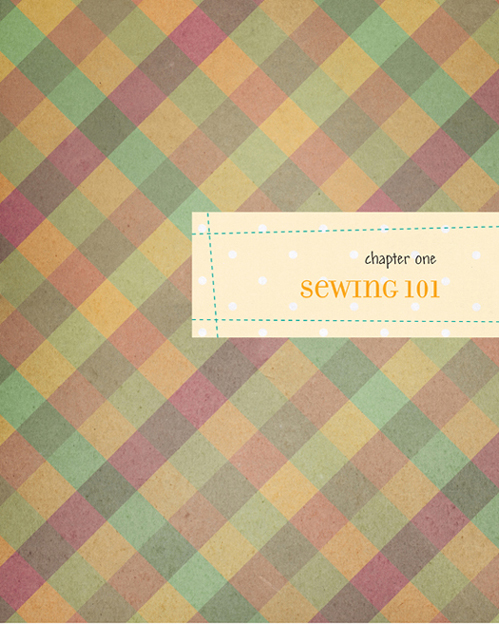

 hese are sewing’s basic moves, moves I learned in middle school while hammering out a teal sweatshirt (yes, teal) and humming Boyz II Men (“Although we’ve come … to the end of the rooooad …”).
hese are sewing’s basic moves, moves I learned in middle school while hammering out a teal sweatshirt (yes, teal) and humming Boyz II Men (“Although we’ve come … to the end of the rooooad …”).
In practicing these basics, grab your needles and thread and make sure you’ve got lots of light (and a good playlist on in the background) (see this page). Working at a desk or dining room table where you can set out your needles and spools of thread is ideal; however, you can couch it as long as you don’t have butterfingers! Hidden needles in the upholstery are nobody’s picnic. (Tush + needles = a bloodcurdling scream rivaling Janet Leigh’s in Psycho.)

If you’re one of those people who say, “but I can’t even sew a button,” prepare to remove that excuse from your vocabulary. With just some needles, a little bit of thread, and the ability to tie a knot, you can hand sew your little heart out!
There are a bunch of different kinds of stitches that you can learn, but we’ll begin with the easiest and most useful (in my humble opinion)—the top three I use all the time.
Running stitch: Prepare to master this basic stitch in no time—easy, breezy, and doable for anyone.
1. Grab a piece of thread. I usually trim thread longer than necessary because it’s better to have too much than not enough and run out before you’re done. A good amount to keep in mind is about 1.5 to 2 times the length of the piece you need to stitch. Tie a knot at one end and take the other end and thread it through the eye of a needle.
2. Bring the needle up through the underside of the fabric (the knot will let you know when to stop). Bring the needle back down about 1⁄8 inch away from your first point.
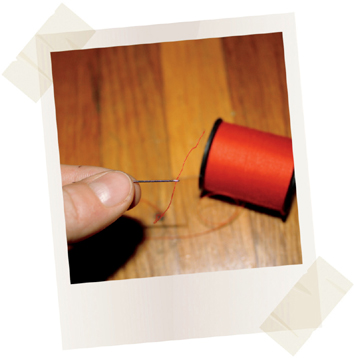
3. Begin stitching from right to left, with evenly spaced stitches. The spacing between these stitches should be small, technically, but you can eyeball about 1⁄8 inch between stitches—do what works for you and the piece.
4. Repeat Steps 2 and 3 until a seam is finished, a hole is mended, or you want to take a snack break to Yogurtland.
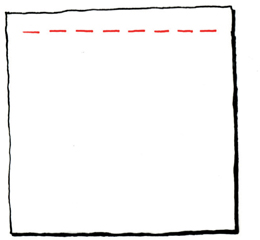
A BASTING STITCH
is virtually the same as a running stitch, but with lots more room between the stitches. Basting stitches are used mostly as a temporary fix or hold, as they’re easy to remove.
Backstitch: This stitch is one of the strongest, great at keeping seams together—meaning you won’t have to worry about your pants tearing at the seam again when you drop your phone for the hundredth time.
This happened to me and I didn’t have anything to tie around my waist. Two words. Epic. Fail.
I think of this stitch as drawing an ocean wave—it goes forward, then back a little, then forward more, and back a little more.
1. Bring a threaded needle up through the underside of the fabric. Bring the needle back down 1 inch forward from where the needle came through.
2. Bringing your needle backward through the underside of the fabric in the middle of the stitch that was made, go another inch forward and bring the needle back down through the fabric.
3. Now bring your needle backward through the underside of the fabric again (in the middle of the last stitch) and make another stitch forward.
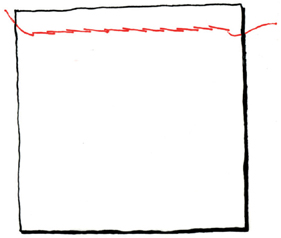
4. Continue this forward, backward, forward, backward movement until the seam has been stitched up.
Overcast stitch: There’s nothing foggy about this stitch, (insert drum badump-ump here,) which is perfect for sewing appliqués or fabric on tank tops. The zigzaggy overcast stitch is my favorite for putting patches or felted shapes on outfits because it gives a total handmade look.
1. Bring the needle through the underside of the fabric and bring it back down about 1⁄2 inch through the top of the fabric, on a slant.
2. Bring the needle back through the fabric from underneath and continue until you’re through. With each stitch continue to move along the edge of the fabric, progressing farther along as you go.
3. Continue making diagonal stitches along the outside edges of your fabric or appliqué, and back through the fabric.
It’ll look like a pine tree/feather you drew in elementary school.


Sewing machines can be daunting if you’ve never used one. However, when you become one with the machine, you’ll be hanging out and having cocktail hour together.
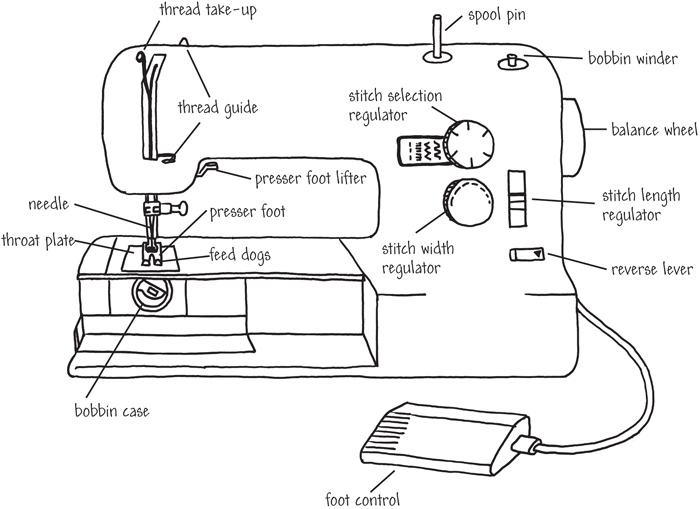
Beginner machines: All the major brands—Elna, Brother, Kenmore, and Singer—make great machines for beginners, from mechanical to electronic and computerized—it’s like Max Headroom is running the machine! You don’t have to spend a lot either—many are under a hundred dollars! Head to retailers like Target or Walmart for a brand-new one, or scope out Craigslist for deals from people getting rid of the machines collecting dust in their attics.
If you’re nervous about jumping into a sewing machine purchase, or want to test the waters first, sign up for a sewing class at a local community college or sewing store. They’ll have a machine (and a teacher) to help you get comfortable before you decide to throw down Benjamins and buy your own.
Machine stitches: Each sewing machine gives you a bunch of different options to choose from:

The straight stitch is the one I use most often and it is exactly what it sounds like. Straight stitches in a row, forming a line across the fabric.
The zigzag stitch is perfect for attaching patches for a homemade look, making buttonholes, sewing stretch material, or even creating free-form letters. This stitch looks just like the front of Charlie Brown’s shirt.
There’s another zigzag stitch, the three-step zigzag stitch (not to be confused with a square-dance move), that looks similar to the zigzag stitch just mentioned. This stitch is most ideal for elastics or jersey knit because the zigzags are wider, giving more room for stretch and movement.
The blind hem stitch works as an invisible (kind of like Patrick Swayze in Ghost) stitch, perfect for hemming curtains or a skirt bottom. It’s a mix of straight and zigzag stitches.
Many machines also include decorative stitches (like the blanket stitch, satin stitch, or whip stitch) for those who want to showcase their super-excellent sewing skills with fancy monograms.
Machine stitch lengths: Just like the saying: “Liquor before beer, you’re in the clear; beer before liquor makes you sicker,” I came up with a line for cautioning about stitch lengths:
“Short and sweet with no repeats;
long and loose probably reproduce.”
This reminds me that the shorter the stitch the more durable it will be (hopefully you won’t have to sew it more than once), and the longer the stitch the greater the likelihood you’ll have to redo it. Stitch lengths will range from less than 1 to 6 millimeters, or 4 to 24 stitches per inch (these are the two scales of measurement). Looking at lengths, finer fabrics (satin) will be 1 or 2 mm; medium-thick fabric (cotton, linen) will stay right in the center at a length of 2.5 or 3 mm; and thicker fabrics (denim, corduroy) will be 4 or 5 mm.
Machine needles (also see “Needles”): Choosing the right needles for sewing different fabrics is like wearing the right clothes for each season. In summer you wear lighter clothing (and less of it), while in winter you wear layers of thicker clothing. Likewise, the thinner your fabric, the smaller the needle you’d use. Machine needles are sized “60/8” (smallest) to “120/19” (largest), with the first number associated with the diameter of the needle’s shaft multiplied by 100 and the second number associated with the U.S. measuring system.
Bobbins (also see “Bobbins”): Bobbins are a necessity for the sewing machine. A bobbin is to a spool of thread as Kid Sister is to My Buddy. Sorry if I got that commercial jingle stuck in any of your heads. They are mini spools that the thread is wound around beneath the throat plate inside the machine. The throat plate creates the stitches on the underside of the garment when sewing—the thread from the spool makes the top stitches—and without bobbins, the machine is just a big rectangular paperweight.
Wind That Bobbin!
1. Pick your thread and put it on the spool holder.
2. Take an empty bobbin and put it on the bobbin winder.
3. Pull the thread to the left and wrap it around the tension disk once, bringing it toward the bobbin winder on the right.
4. Wrap the thread clockwise around the bobbin a few times or bring the thread through the pinhole in the top of the bobbin, depending on the kind of bobbin you’re using. Place the bobbin on the winding spindle.
5. Push the bobbin winder (with the bobbin on it) to the right until you hear the winder click in place.
6. Begin to press the foot pedal and the bobbin will spin, winding thread around it.
7. I like to have full bobbins, so continue to press the foot pedal until the bobbin is almost completely wound with thread. Some machines automatically stop when the bobbin is full, but if your machine doesn’t, keep an eye on it at the 3⁄4 point and stop it before it overflows at the bobbin’s edge. You want the thread as smoothly wound as possible.
For additional tips on using a sewing machine see chapter 2: Muumuu Transformations, Look 1. And remember, all sewing machines work differently, so refer to your machine manual for more detailed instructions.